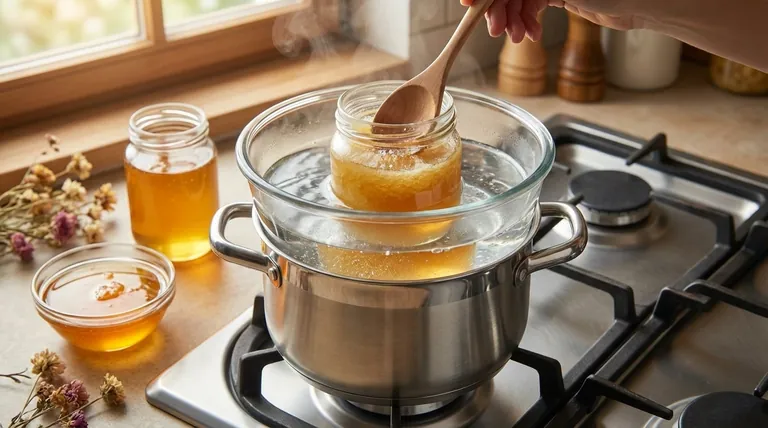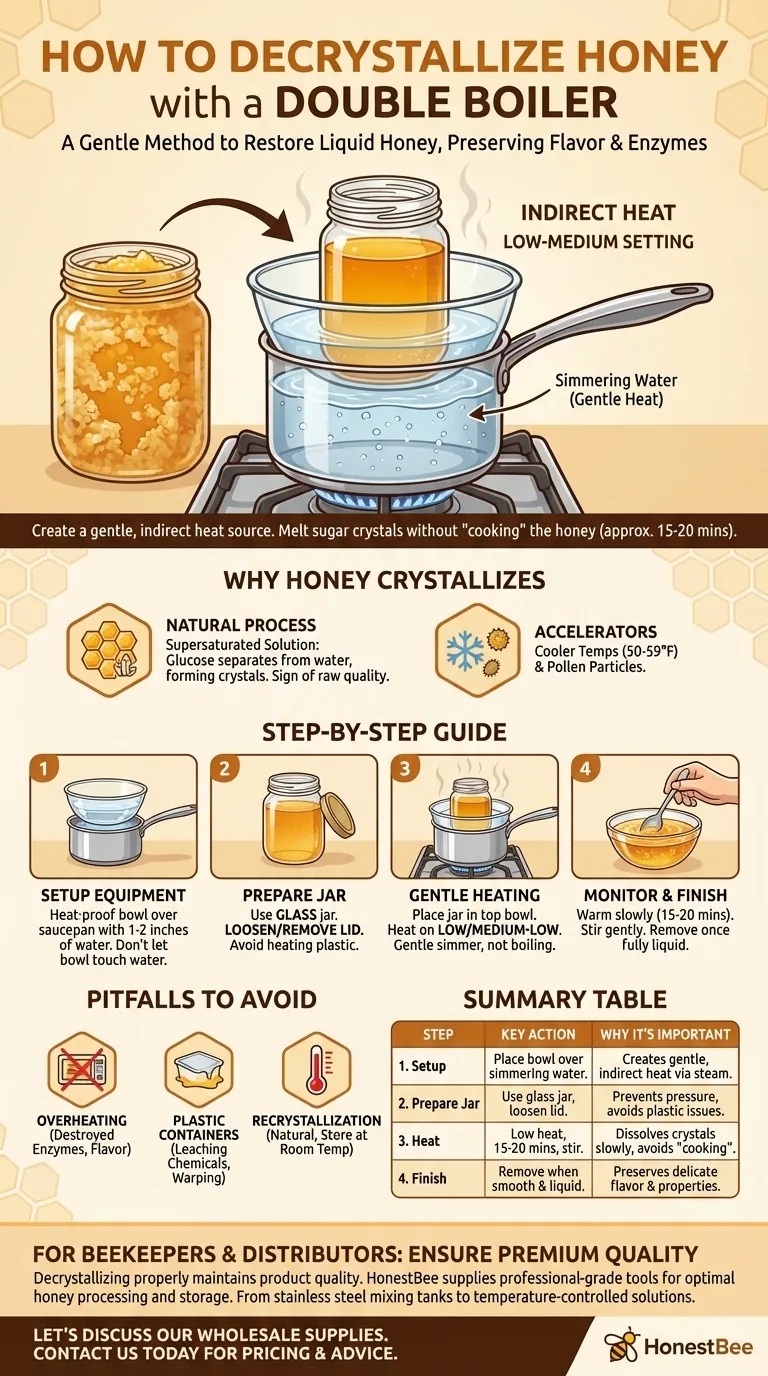To decrystallize honey with a double boiler, you create a gentle, indirect heat source that melts the sugar crystals without damaging the honey. Place your honey jar in the top pot of a double boiler or a heat-safe bowl set over a saucepan of simmering water, and heat it slowly for 15-20 minutes until the honey returns to a smooth, liquid state.
The core principle is not about speed, but about control. The goal is to apply low, gentle heat to dissolve the glucose crystals without "cooking" the honey, which would degrade its flavor and beneficial enzymes.

Why Honey Crystallizes in the First Place
A Natural and Reversible Process
Crystallization is a completely natural phenomenon and not a sign that your honey has spoiled. In fact, it's a sign of high-quality, raw honey.
Honey is a supersaturated solution of two main sugars: glucose and fructose. Glucose has lower solubility than fructose, causing it to separate from the water and form tiny crystals over time.
The Role of Temperature and Pollen
This process is often accelerated by cooler temperatures (around 50-59°F or 10-15°C). The presence of small particles, like bits of pollen, can also act as starting points for crystals to form.
A Step-by-Step Guide to the Double Boiler Method
H3: Setting Up Your Equipment
You don't need a dedicated double boiler. You can easily create one by placing a heat-proof bowl (like glass or stainless steel) over a saucepan.
Add just an inch or two of water to the bottom saucepan. The top bowl should rest on the rim without touching the water below; the steam will provide the heat.
H3: Preparing the Honey Jar
This method works best with honey in a glass jar. If your honey is in a plastic container, it's safest to transfer it to a glass jar before heating.
Make sure to loosen or remove the lid from the jar before placing it in the top bowl of your double boiler.
H3: The Gentle Heating Process
Place the honey jar into the top bowl and turn the stove on to a low or medium-low setting.
Your goal is to bring the water in the bottom pot to a gentle simmer, not a rolling boil. The steam is more than enough to gently heat the honey.
H3: Monitoring and Finishing
Allow the honey to warm slowly. After 15-20 minutes, you can stir it gently to help break up the crystals and distribute the heat evenly.
Once all the crystals have dissolved and the honey is fully liquid, carefully turn off the heat and remove the jar.
Understanding the Pitfalls to Avoid
H3: The Danger of Overheating
The most common mistake is applying too much heat. Boiling honey can destroy its delicate aromas, alter its flavor, and degrade the naturally occurring enzymes that make it beneficial. Never microwave honey, as it heats unevenly and creates super-hot spots that will effectively cook it.
H3: The Plastic Container Problem
Heating honey directly in a plastic container is not recommended. At high temperatures, chemicals can potentially leach from the plastic into your honey, and the container itself could warp or melt.
H3: The Cycle of Recrystallization
Once you decrystallize honey, it can and likely will crystallize again over time. To slow this down, store your honey in a sealed container at a stable room temperature.
How to Apply This to Your Honey
- If your honey is in a glass jar: The double boiler or a simple warm water bath is the ideal method for safely preserving its quality and flavor.
- If your honey is in a plastic container: Your safest option is to scoop the crystallized honey into a glass jar before heating. If that's not possible, use a very low-temperature water bath and remove it as soon as it liquefies.
- If you only need a small amount: Consider warming just the portion you need for immediate use to avoid repeatedly heating the entire jar, which can slowly degrade its quality over time.
By understanding the principle of gentle heat, you can confidently restore your crystallized honey to its perfect liquid state every time.
Summary Table:
| Step | Key Action | Why It's Important |
|---|---|---|
| 1. Setup | Place a heat-proof bowl over a saucepan with simmering water. | Creates a gentle, indirect heat source from steam. |
| 2. Prepare Jar | Use a glass jar and loosen the lid. | Prevents pressure build-up and avoids plastic leaching. |
| 3. Heat | Heat on low for 15-20 minutes, stirring occasionally. | Dissolves crystals slowly without 'cooking' the honey. |
| 4. Finish | Remove from heat once smooth and liquid. | Preserves the honey's delicate flavor and beneficial properties. |
For Beekeepers and Distributors: Ensure Your Honey Stays Premium
Decrystallizing honey properly is crucial for maintaining product quality. At HONESTBEE, we supply commercial apiaries and beekeeping equipment distributors with the professional-grade tools needed for optimal honey processing and storage. From stainless steel mixing tanks to temperature-controlled storage solutions, our wholesale-focused operations provide the reliable equipment that protects your product's integrity and your brand's reputation.
Let's discuss how our supplies can support your operation. Contact our team today for wholesale pricing and expert advice.
Visual Guide

Related Products
- Honey Concentrating and Filtering Dehumidifier Machine 2T Capacity for Honey
- 10L Stainless Steel Electric Honey Press Machine
- Natural Wood Honey Dipper for Tea Coffee and Desserts
- Economy Small Scale Honey Dryer Dehumidifier Thickening Machine
- Stainless Steel Manual Honey Press with Guard for Pressing Honey and Wax
People Also Ask
- What are the advantages of the honey vacuum thickener equipment? Preserve Quality & Boost Efficiency
- What is the humidity extraction capability of the honey dryer? Achieve Perfect Honey Moisture Control
- How to decrease moisture in honey? Prevent Fermentation and Ensure Long-Term Quality
- How does centrifugation work in honey extraction? The Sustainable Method for Modern Beekeepers
- What principle does the honey vacuum thickener use to concentrate honey? Preserve Quality with Low-Temperature Evaporation



















